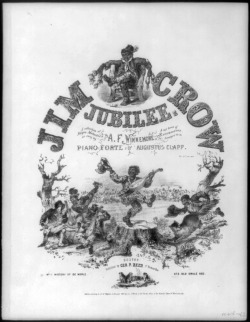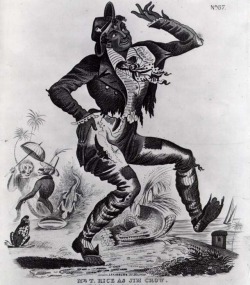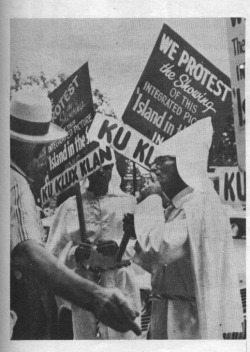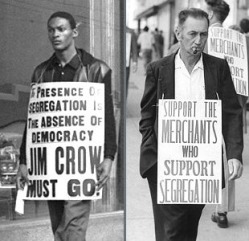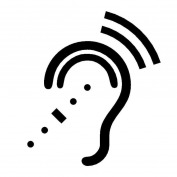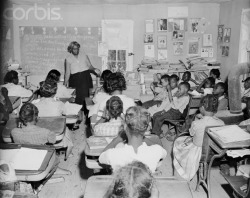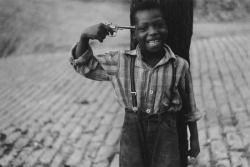What is segregation?

http://faculty.umf.maine.edu/~walters/web%20104/30s%20parks%20segregation.jpg
Racial Segregation was exactly what it sounds like: segregation of the races. Ther term segregation meant the act of not mixing the races. Segregation did not only mean that public places were segregated; Segregation also meant that terrible acts of violence were often commited against those of a different race. There were many groups that supported segregation and tormented those of color. In this picture of the African American woman at the "colored-only" water fountain, you see one of the many examples of things that were segregated. The point of segregation was to dicrminate against and make people of color seem inferior to the white race. It accomplished its goals for many years, but it finally came to a stop because of the persistant courage of Civil Rights Activists.
What was segregation based on?

http://oliverwillis.typepad.com/photos/uncategorized/2007/07/31/segregation.jpg
Segregation was strictly based on race. It didn't matter how rich you were or how well you presented yourself; if you were not white, you would not be experiencing the "whites-only" priveledges. Segregation has not always been based on the color of skin. In Nazi-Germany, Jews were segregated and discriminated against. Now, one could say that gender and sexual orientation are discriminated against in numerous ways; but during the Civil Rights Era, Charlotte was segregated based on the color of skin.
What was segregated in Charlotte?
Schools
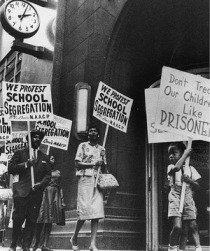
http://image3.examiner.com/images/blog/EXID33355/images/resized_502px_School_segregation_protest.jpg
One of the saddest things to see segregated in Charlotte was the school system. There was a significant difference in the quality of education one would recieve by attending a black school versus a white school. In black schools, resources were always scarce. The few resources they did have were always second-hand and had already been used by white students many times over. There were usually marks in the textbooks and most of the pages were drawn on and ripped. Those students in the black schools always felt a second-class citizenship in Charlotte's school system. Even though conditions were tough in black schools, the students generally felt safe there. This would all change when school integration began.
Theaters

http://www.cmhpf.org/Morrill%20Book/CH12.htm
This building was known as The Savoy Theater. It was located on Rozzelles Ferry Road and was for Blacks only. The Savoy theater was one of the four theaters in Charlotte that were for Blacks only. It is located near where the Aquatic Center is in Charlotte today. Films would finally come to be shown in the Black theaters after they had been shows in the white theaters for several weeks.
Transportation
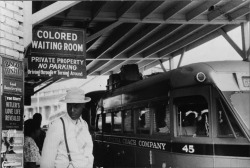
http://upload.wikimedia.org/wikipedia/commons/5/59/JimCrowInDurhamNC.jpg
Transportation was one of the earliest things to be segregated under the Jim Crow Laws. In every case, the facilities for Blacks were inferior to those provided for Whites. Some examples of things segregated in transportation were train depots, waiting rooms, ticket windows, toilet facilities, and more. Waiting rooms for Blacks consisted of a hot stuffy room with no fans or air conditioners and broken furniture. The Black car of the train was located in the back of the train where all the suit from the smoke would land. The Black car was also used for whites to come and take smoke breaks, which made it the dirtiest and worst smelling train car of all. "Often, unruly white passengers, looking to alleviate their own boredom, would come and insult, humiliate, or beat African American passengers. When this happened, the victims of the white ruffians had no recourse; The conductor would never intervene." (Sharp)
Diners
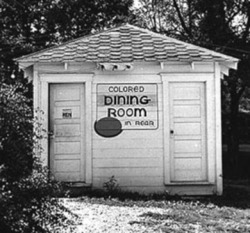
http://thedarkprophet.wordpress.com/2007/09/11/modern-segregation/
Many restaurants and diners in Charlotte were segregated. Can you imagine walking into a restaurant and having someone tell you that you are not worthy to eat there? Some restaurants would sell their food to Blacks, but they would have to come around to the back of the diner to pick it up. They were not allowed to actually come in like human beings and eat amongst the Whites. Some diners had separate eating areas for Blacks. This picture shows an example of what this type of area looked like.
Water Fountains
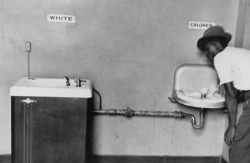
http://www.inquisitr.com/wp-content/limbaugh-segregation1.jpg
This picture was taken of an actual water fountain in Charlotte, North Carolina. This water fountain has been placed in the Levine Museum of The New South. It is clear that the white water fountain is refridgerated, while the black water fountain is not. It must have been so degrading to walk up to this fountain and drink room temperature water while a white person drink cool, refreshing water; as if whites were more deserving than blacks. In this picture, it is almost like the man in the picture is looking over at the white water fountain, wondering why he doesn't deserve to drink from that fountain.
The Grand Pharr Theater
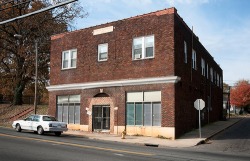
http://www.cmhpf.org/Grand_Pharr_Building.jpg
This building, known as The Grand Theater is located at 333 Beatties Ford Road in Charlotte. It is the only surviving movie theater that was for blacks only in Charlotte during the Jim Crow Era. The Grand Pharr Theater is a key part of Biddleville, one of Charlotte's oldest surviving black neighborhoods, located near Johnson C. Smith, which is Charlotte's only Black college.
How did segregation come about?
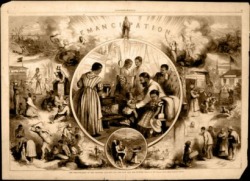
http://www.arkansastoothpick.com/emancipation07.jpg
The North's victory in the Civil War in 1865 freed 4 million African American slaves. Rights were garunteed to these newly freed slaves to obtain freedom and equality. The resistance of the Southern Whites put an overpowering block on these rights for the African American newly-freed slaves in the south. The slave-owners in the south had to accept the end of slavery, but that did not stop them from believing that they were still superior to Blacks. It was for that reason that the Jim Crow Laws were created. The Jim Crow Laws discriminated against Blacks in every way possible. "Historian Roy L. Brooks elaborates by saying that African Americans under both slavery and Jim Crow lived in a state of abject, absolute inequality. In all spheres of life, they had less that whites: less income, wealth, occupational prestige, housing, education, and political influence." (Sharp)
Who supported segregation?
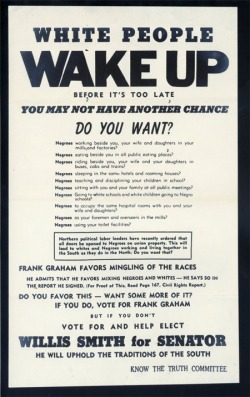
http://www.learnnc.org/lp/editions/nchist-postwar/6103
After having all their slaves freed, white southerners searched for other ways to keep control over Blacks. Abraham Lincoln, president at the time, was close to proposing that Blacks get the right to vote, when he was assasinated. Andrew Johnson, a white southerner, took over as president of the United States on April 14, 1865. Andrew Johnson openly expressed his opposition to protecting or exanding the rights of Black Americans. Another organization formed to maintain white supremecy in the South. It came to be known as the Ku Klux Klan. The organization was formed in Tennesse in 1866 and consisted of mostly confederate veterans. The Klan used violence to send a message of white domination over blacks in the south.
What was it like to live in Charlotte during segregation?
"Separate, but NOT equal..."

http://artfiles.art.com/5/p/LRG/26/2699/2JRUD00Z/stan-wayman-african-american-citizens-sitting-in-the-rear-of-the-bus-in-compliance-with-florida-segregation-law.jpg
Below are some oral first-person accounts of what it was like to live in Charlotte, North Carolina during segregation. When you see the ear symbol, click on it and it will take you to the webpage to listen to the oral account. You simply need to hit the play button. Below the play button, you can read the transcript while you listen.
Interview with Ben Harton, raised in Dilworth during segregation:
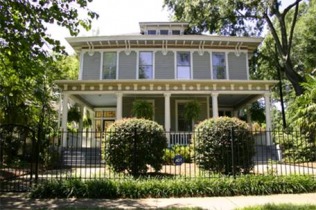
http://www.cmhpf.org/Surveys&rCityHouse.htm
Click on the file below to read the interview of Ben Harton, raised in Dilworth during segregation...
| ben_harton_of_dilworth_interview.doc |
Pre-dominantly Black Neighborhoods
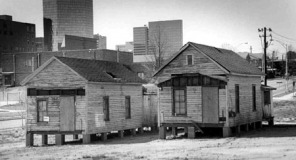
http://www.cmhpf.org/surveyafricanamtypes.htm
"The shotgun house was once the most prominent housing type in Charlotte’s black neighborhoods. The two houses now sit on the grounds of the Old Little Rock AME Zion Church, now the African American Cultural Center, as a historical exhibit."
